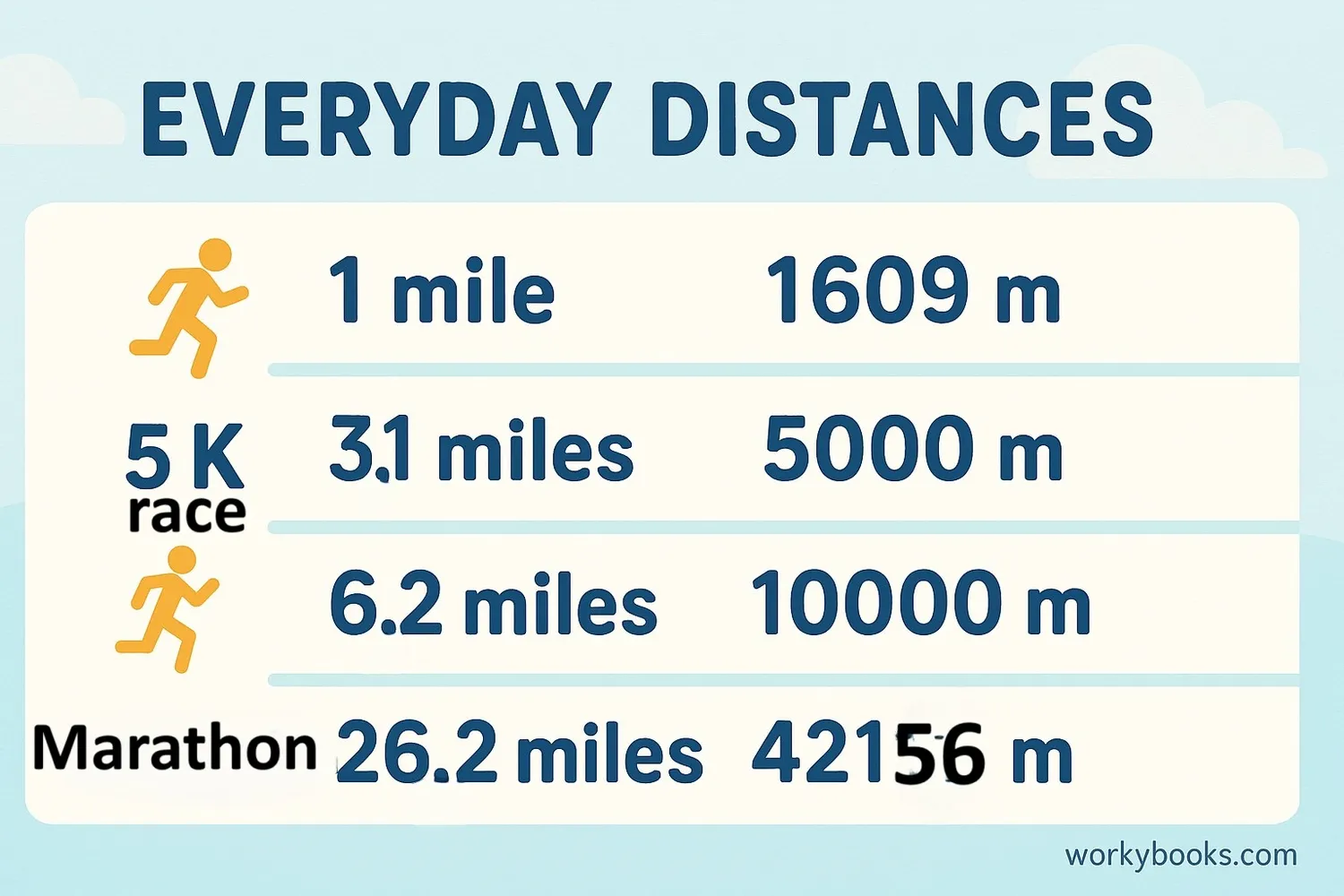Miles to Meters (mi to m) - Definition, Examples, Quiz, FAQ, Trivia
Learn to convert between imperial and metric length measurements with simple explanations and practice activities
What is Miles to Meters Conversion?

Length conversion means changing a measurement from one unit to another. In this lesson, we're learning how to convert between miles (used in the imperial system) and meters (used in the metric system).
Why do we need to convert? Different countries use different measurement systems. Most countries use meters and kilometers, while the United States primarily uses miles and feet. Scientists also use metric measurements for consistency.
One mile equals 1,609.344 meters. To convert miles to meters, we multiply the number of miles by 1,609.344. Understanding this relationship helps us compare distances and solve real-world problems.
Key Concept
1 mile = 1,609.344 meters. This relationship is the foundation for all miles-to-meters conversions.
How to Convert Miles to Meters
Converting miles to meters is straightforward once you remember the conversion factor:
Conversion Formula
To convert any measurement in miles to meters, multiply the number of miles by 1609.344.
Example: Convert 2 miles to meters
Step 1: Start with the measurement in miles → 2 miles
Step 2: Multiply by 1609.344 → 2 × 1609.344
Step 3: Calculate the result → 3,218.688 meters
So 2 miles equals 3,218.688 meters. That's about 32 football fields!
Remember
When converting miles to meters, your answer will be a larger number because meters are smaller units than miles.
Miles to Meters Conversion Charts
Conversion charts help us quickly find equivalent measurements without calculating each time. Here are two useful charts for converting miles to meters:
Miles to Meters Distance Conversion Chart
| Miles (mi) | Meters (m) | Approximate Equivalent |
|---|---|---|
| 0.5 | 804.672 | 8 football fields |
| 1 | 1,609.344 | 16 football fields |
| 2 | 3,218.688 | 32 football fields |
| 3 | 4,828.032 | 48 football fields |
| 5 | 8,046.72 | 80 football fields |
| 10 | 16,093.44 | 160 football fields |
| 26.2 | 42,195 | Marathon distance |
Common Miles to Meters Conversion
| Miles (mi) | Meters (m) |
|---|---|
| 0.1 | 160.934 |
| 0.25 | 402.336 |
| 0.5 | 804.672 |
| 1 | 1,609.344 |
| 2.5 | 4,023.36 |
| 5 | 8,046.72 |
| 10 | 16,093.44 |
Chart Tip
Notice how each additional mile adds 1,609 meters? You can use this pattern to estimate conversions!
Real-World Examples

Let's practice conversion with some real-world examples:
Example 1: A 5K race is 3.1 miles long. How many meters is this?
Solution: 3.1 × 1609.344 ≈ 5,000 meters (that's why it's called a 5K!)
Example 2: The distance from New York to Boston is about 190 miles. Convert this to meters.
Solution: 190 × 1609.344 ≈ 305,775 meters
Example 3: A football field is 100 meters long. How many miles is this?
Solution: To convert meters to miles, divide by 1609.344: 100 ÷ 1609.344 ≈ 0.062 miles
Example 4: The distance around a standard running track is 400 meters. How many miles is this?
Solution: 400 ÷ 1609.344 ≈ 0.249 miles (about a quarter mile)
Practice converting distances you encounter - your walk to school, a car trip, or the length of your street!
Conversion Tip
To convert meters back to miles, divide by 1609.344 instead of multiplying.
Conversion Practice Quiz
Test your conversion skills with this 5-question quiz. Choose the correct answer for each question.
Frequently Asked Questions
Here are answers to common questions about miles and meters conversion:
Measurement Trivia
Discover interesting facts about measurement systems:
Origin of the Mile
The mile originated from the Roman "mille passus" meaning "a thousand paces." Each pace was two steps, so a mile was 5,000 Roman feet. Today's mile is longer at 5,280 feet.
The Meter Standard
The meter was originally defined in 1793 as one ten-millionth of the distance from the equator to the North Pole. Today it's defined by the distance light travels in a vacuum in 1/299,792,458 seconds.
Space Measurements
NASA uses metric measurements for all its space missions. The Mars Climate Orbiter was lost in 1999 because one engineering team used metric units while another used imperial units.
Longest Distance
The longest road in the world is the Pan-American Highway, stretching about 19,000 miles (30,600 km) from Alaska to Argentina. That's equivalent to 30,577,536 meters!


